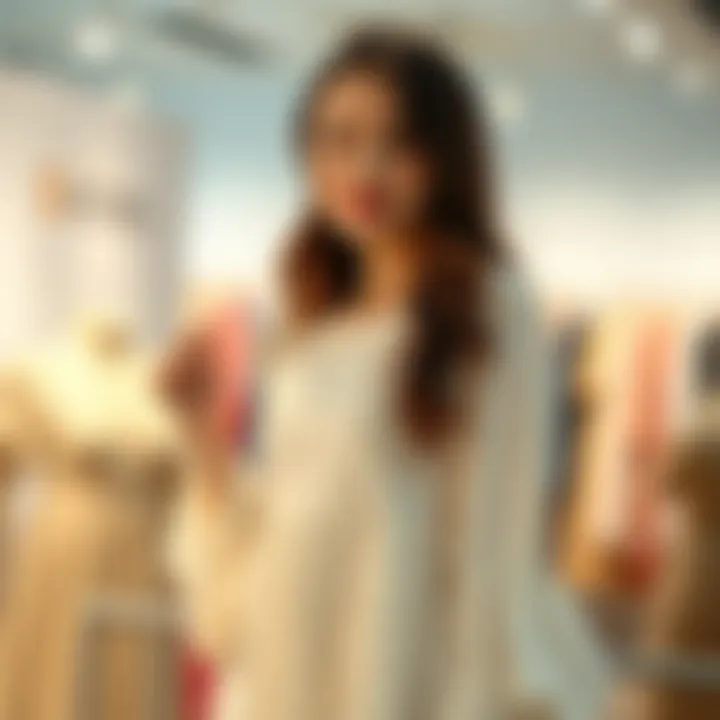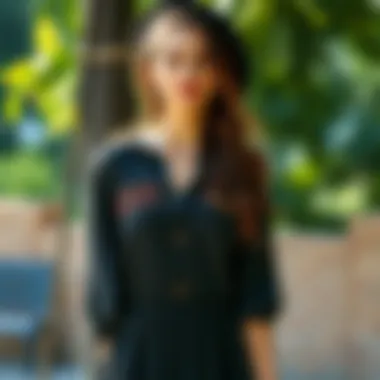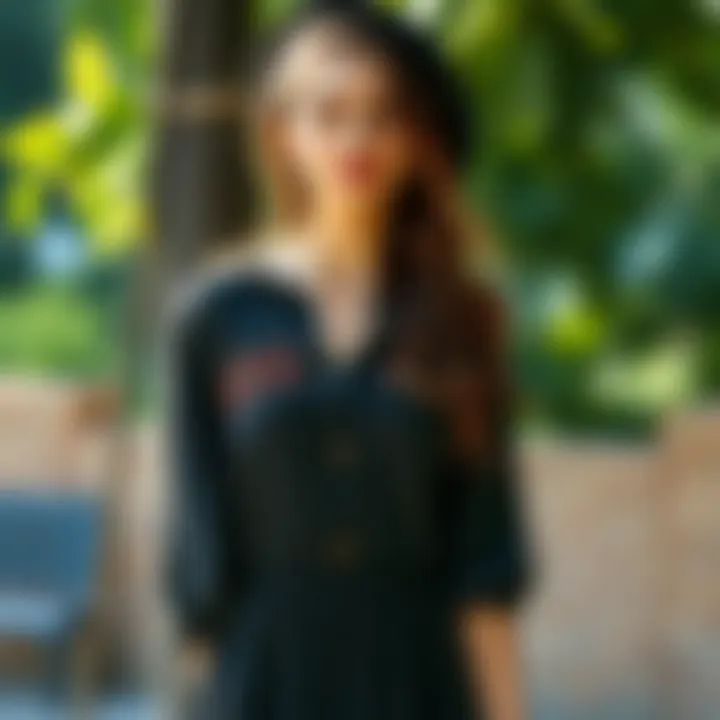Exploring Ladies Casual Dresses with Sleeves


Intro
When you think about a wardrobe staple that combines comfort, versatility, and a dash of style, ladies' casual dresses with sleeves often come to mind. These dresses not only serve practical purposes such as providing coverage and warmth but also hold a unique place in the fabric of fashion history. From the classic tea dresses of the 1950s to the flowy styles embraced by contemporary designers, the evolution of this garment reflects shifting societal norms and preferences.
This guide aims to unpack the layers surrounding ladies' casual dresses with sleeves. We will traverse through various dimensions, including the current fashion landscape, historical significance, fabric choices, and particular styling tips that will allow fashion enthusiasts and professionals to navigate this domain effectively. Whether you’re seeking to enhance your personal style or working in the fashion industry, understanding these elements can empower your choices and inspire creative expression.
Fashion Trends
Latest Seasonal Trends
In the ever-changing realm of fashion, seasonal trends play a crucial role in determining what garners attention each year. Recently, we've seen a shift towards lightweight fabrics that allow breathability while providing ample coverage, which is essential during warmer months. Floral patterns, soft pastels, and earthy tones dominate the landscape, creating an inviting vibe that resonates with the casual aesthetic. Furthermore, oversized sleeves and asymmetrical hemlines have made their mark, providing a modern twist to traditional silhouettes.
Another noticeable trend is the rising awareness of sustainability in clothing. More brands are leaning towards eco-friendly materials, such as organic cotton, linen, and recycled fabrics, reflecting a growing consumer demand for responsible fashion choices. These alternatives not only align with ethical consumerism but also offer comfortable, breathable options suitable for everyday wear.
Iconic Styles Revived
Drawing inspiration from the past, certain iconic styles are making a comeback this season. The return of the A-line silhouette, for instance, is garnering attention for its flattering shape that suits various body types. Meanwhile, the shift dress has been reimagined with modern fabrics and patterns, providing both comfort and style. Moreover, the bohemian vibe is strong, as we observe long-sleeved maxi dresses adorned with intricate embroidery and bold prints, reminiscent of the artistic movements of the 70s.
These resurgences do not exist in isolation; they are often accompanied by contemporary adaptations that connect tradition with today’s aesthetics. As style enthusiasts, being aware of these trends not only helps in making informed purchases but also allows for personal expression through a blend of classic and current styles.
"Fashion is the armor to survive the reality of everyday life."
— Bill Cunningham
Style Tips
How to Mix and Match
One of the distinguishing features of ladies' casual dresses with sleeves is their adaptability. These garments can be styled in numerous ways, making them suitable for various occasions—from casual outings to semi-formal events. To maximize the versatility of a simple dress, consider layering it with a lightweight cardigan or a denim jacket. This way, you can effortlessly transition from day to night.
Footwear plays a vital role in setting the tone of your outfit. Pairing a floral dress with ankle boots can lend a bohemian flair, while stiletto heels can elevate a casual dress to make it evening-ready. Additionally, accessories, like a statement belt or a vibrant scarf, can enhance the overall look, allowing for personal touch and creativity.
Dressing for Different Occasions
When selecting a dress to attend various events, consider the setting and the overall desired aesthetic. For a picnic in the park, a short-sleeved, knee-length dress paired with flats is comfortable and chic. In contrast, when invited to a brunch or casual office meeting, opt for a longer dress with tailored sleeves that can convey professionalism while still retaining comfort.
The fabric of the dress also influences its suitability for different occasions. Lightweight cotton or jersey dresses are perfect for relaxed family get-togethers, while a more structured dress in a heavier fabric can be appropriate for outings that require a bit more polish. The key lies in balancing comfort with context; embodying both ease and style at the same time.
This comprehensive guide outlines the multifaceted aspects of ladies' casual dresses with sleeves, from understanding current trends to practical styling advice. For further exploration on fashion history, trends, and materials in clothing, consider resources such as Wikipedia and Britannica that can provide deeper insights into the subject.
Prologue to Casual Dresses with Sleeves
When it comes to enhancing a woman’s wardrobe, casual dresses with sleeves hold a significant spot. They offer a perfect blend of style and practicality, catering to various occasions, body types, and personal expressions. Unlike their sleeveless counterparts, these dresses provide the added benefit of comfort while allowing for versatility across seasons.
Why Casual Dresses with Sleeves Matter
The importance of casual dresses with sleeves lies not only in their aesthetic value but also in their functionality. Here's a few reasons why:
- Layering Potential: Sleeved dresses can easily serve as a base for layering. Whether paired with a stylish jacket during colder months or accessorized with a light scarf, they adapt readily to changing weather.
- Modesty Meets Style: For many, sleeves offer a sense of comfort and modesty. They allow for personal expression while respecting cultural or personal preferences concerning clothing.
- Broad Appeal: These dresses are a staple in many women’s wardrobes. From young professionals to mothers on the go, their versatility makes them suitable for different life stages and events.
Key Elements of Casual Dresses with Sleeves
In navigating the world of casual dresses with sleeves, it’s critical to consider the variety of styles available, such as:
- Shift Styles: These provide a relaxed fit, allowing for easy movement. Great for everyday wear.
- Flared Sleeves: Adding a touch of flair, these sleeves can take a simple dress into a more fashion-forward territory, contributing to both a modern and whimsical appearance.
- Maxi Lengths: Ideal for those who prefer floor-grazing silhouettes, they offer a breezy and feminine look, perfect for summer outfits.
"Casual dresses with sleeves are not just clothes; they represent stories of comfort, style and individuality."
Conclusion of the Preface
In summary, casual dresses with sleeves are more than just a fashion statement; they are a reflection of personal style and lifestyle needs. The broad selection available in terms of styles, cuts, and fits equips every woman to find something that speaks her language of comfort and aesthetics. This guide will explore the various dimensions of these dresses, making sure no stone is left unturned in the realm of casual fashion.
Historical Context
Understanding the historical context of casual dresses with sleeves sheds light on how fashion evolves through time. This exploration not only highlights trends from different eras but also reveals how cultural and societal changes shape women's clothing choices. Over the years, casual dresses have shifted from restrictive designs to more relaxed styles, reflecting women's growing independence.
Evolution of Women’s Fashion
Women's fashion has seen a whirlwind of changes, shaped by societal norms, technological advances, and cultural movements. In the early 20th century, for example, suffragettes wore dresses that were liberating yet modest, allowing for movement while advocating for their rights. Such transformations mirrored a deeper call for freedom and autonomy among women.
With the advent of the 1920s, dresses took on a whole new shape. Flapper dresses, often characterized by short sleeves, ruled the era, symbolizing a breakaway from traditional values. As women stepped into public life in unprecedented numbers, their clothing reflected this boldness. Designers like Coco Chanel revolutionized women's wear, inspiring a mix of comfort and chicness that echoed throughout time.
By the 1960s, casual dresses saw yet another transformation. Embracing elements from the previous decades, the styles brought forth a sense of casual elegance. Mini-skirts and A-line cuts became the order of the day. The impact of the feminist movement during this time cannot be understated; it fostered a dialogue about body autonomy, comfort, and personal expression—all of which are interwoven with the notion of sleeves. Sleves began to be seen not just as a functional part of clothing, but also as an expressive element of design.
Significance of Sleeves in Fashion
Sleeves are more than just practical components for coverage; they have historically been significant in dictating style and sophistication. The progression of sleeve styles marks pivotal moments in fashion history. For instance, the Victorian era showcased grand, puffed sleeves that underscored status and femininity. The elaborate designs were often a display piece, drawing attention to the wearer’s social standing.
In modern contexts, the significance of sleeves can also be found in their versatility. From the bell sleeves of the 1970s that symbolized freedom to the minimalist designs of the present, sleeves adapt according to the societal mood.
Moreover, sleeves represent an opportunity for personal expression. Wearing a dress with unique sleeve designs can reflect one's individuality. Different styles, such as off-the-shoulder, cap sleeves, or flared sleeves, offer a range of expressions from fun and flirty to sophisticated and professional.
"Fashion is a language that creates itself in clothes to interpret reality." – Karl Lagerfeld
Hence, the exploration of sleeves in dresses is not merely about styles; it encompasses layers of meaning that connect the wearer to broader cultural narratives.
Overall, understanding the historical context of casual dresses with sleeves helps to appreciate how these elements are tied to a rich tapestry of women's rights, personal expression, and societal shifts. By examining the evolution of women's fashion and the significance of sleeves, we can better grasp the cultural importance embedded within casual dresses today.
Varieties of Casual Dresses
When we look at ladies' casual dresses, the choices seem to overflow like sweets at a candy store. Each variety serves a distinct purpose and can dramatically shape not just appearance but also comfort and confidence. This section peels back the layers of what makes these dresses more than mere clothing. They represent personal style, cultural influences, and practical usability across different little moments in our daily lives.
Styles and Cuts
Shift Dresses
A shift dress is a staple that hangs loosely from the shoulders. This silhouette is all about comfort and ease, making it a go-to choice for many women. The beauty of the shift dress lies in its versatility. Coming in a plethora of prints and colors, it can easily fit a casual day out or even a more polished affair with the right accessories. The key characteristic is its forgiving shape; it skims over the body without clinging, making it particularly inviting. However, while they promote a relaxed vibe, sometimes they might lack definition for certain body types, which could be a downside for some.
Maxi and Midi Lengths


Maxi and midi lengths add an air of elegance to casual dresses. These lengths are loved for their flowing designs that can be airy in warm weather yet effortlessly layered in chillier climes. The maxi dress, in particular, often dances around the ankles, giving it a whimsical feel that speaks of summer days and carefree outings. Midi dresses, on the other hand, offer a slightly more demure option, hitting mid-calf and providing a dash of sophistication. Yet, they can sometimes pose a challenge for those petite, as the length may overwhelm a smaller frame.
A-Line Silhouettes
The A-line silhouette is truly a classic. Characterized by its form-fitting bodice that flares out from the waist, it creates an iconic shape that flatters virtually all body types. It’s like that one friend who gets along with everyone — easy to style, and perfect for nearly any occasion. This choice is particularly beneficial since it can provide comfort while highlighting the waist. A possible disadvantage? Some might find that the flared skirt can add visual bulk, which is something to keep in mind when choosing fabrics and patterns.
Sleeve Options
Short Sleeves
Short sleeves bring that perfect touch of chill to summer dresses. They allow for movement and keep things light. The openness around the shoulders can breathe life into an outfit, which is especially great during warmer months. Their defining feature is how they strike a balance between casual and polished; they can be styled with ease for day-to-night transitions. However, for those who feel self-conscious about their arms, short sleeves might not always be the first pick.
Three-Quarter Sleeves
Three-quarter sleeves are a bridge between short and long sleeves. This option has gained popularity for its versatility and ability to flatter various arm shapes. They offer a bit more coverage while still maintaining a carefree look. Ideal for transitional weather, these sleeves can easily suit both casual and semi-formal settings. On the flip side, they can sometimes feel like a compromising length; not quite long enough for winter but potentially chilly in spring.
Long Sleeves
Long sleeves scream both elegance and sophistication. Perfect for the cooler seasons, these sleeves provide warmth without sacrificing style. Their adaptability allows them to be dressed up or down, characterizing both casual outings and formal affairs. One key feature of long sleeves is their practicality in layering; they can be worn under jackets or cardigans seamlessly. The downside is they can occasionally feel restricting in hotter climates, making them less favorable for summer dressing.
Flared and Bell Sleeves
Flared and bell sleeves add a unique twist to traditional casual wear. These flared styles can transform a simple dress into a statement piece. Their dramatic flair creates a playful movement, catching the eye and often setting the stage for interesting fashion conversations. A significant advantage is how they draw attention away from the waist, allowing for more room above. Still, their bold design may not be everyone’s cup of tea, potentially overpowering more understated looks.
Materials and Fabrics
When talking about ladies' casual dresses with sleeves, the choice of materials and fabrics plays a fundamental role in their comfort, aesthetic appeal, and functionality. Each fabric carries unique qualities that cater to various preferences and occasions. Understanding these different materials not only helps in selecting the right dress but also enhances the overall experience of wearing it. Balancing style and comfort is essential, making knowledge of fabrics a must-have for any fashion enthusiast or professional.
Natural Fabrics
Cotton
Cotton is perhaps one of the most well-loved fabrics in the world of fashion, especially when it comes to casual dresses. Its breathability influences how ladies feel during warmer days, making it a go-to choice for summer styles. This fabric is not only comfortable but also versatile enough to work for different cuts and designs. One unique characteristic of cotton is its moisture-wicking ability, which means it draws sweat away from the body.
However, it does have its downsides; for instance, pure cotton wrinkles relatively easily. Still, the fabric's durability often affirms its worth, helping it become a staple in many wardrobes.
Linen
Linen stands apart for its distinct texture and crisp finish. It's often associated with high-quality craftsmanship and comfortable wear. Linen dresses have a unique ability to keep the body cool, as it allows for good air circulation, making it perfect for hot climates. Additionally, linen's natural luster adds an element of sophistication to any outfit, which makes it a popular choice for casual yet chic pursuits.
On the flip side, linen is known to wrinkle considerably, which means wearing it sometimes requires a bit more effort, especially when maintaining a polished appearance.
Wool
While many may think of wool exclusively in connection with cold weather wear, it can also find its place in casual dress styles. Wool is an excellent insulator, making it an ideal choice for cooler months. A key characteristic of wool is its elasticity, which allows it to retain its shape while providing comfort. What’s interesting is that there are lightweight wool blends that make them suitable for lighter fashion items too.
Nonetheless, it's important to consider some may find wool a bit itchy or uncomfortable next to their skin, which is something to weigh in choosing your attire.
Synthetic Fabrics
Polyester
Polyester is a fabric that has earned its place in fashion due to its durability and resistance to stretching and shrinking. This synthetic fabric is often blended with others to enhance characteristics across the board. One major benefit of polyester is its colorfast quality, ensuring garments maintain their vibrant hues even after multiple washes. Though it can trap heat, making it less breathable compared to sheer natural fibers, it’s a resilient option for various styles.
Rayon
The allure of rayon lies in its softness and drape. This fabric resembles silk and offers a gentle, flowing silhouette, ideal for casual dresses. Its absorbency helps regulate temperatures, making it a comfortable choice for many climates. However, rayon’s tendency to wrinkle easily and its lesser durability can be hindrances when used for long-term wear.
Nylon
Possessing a glossy sheen, nylon is another synthetic fabric that has etched a solid presence in fashion. Its toughness and moisture-wicking properties make it a popular choice for active wear as well as casual dresses. While it needs some extra care during washing, the fabric’s ability to maintain its shape is a huge plus. However, one must be wary of the potential discomfort sometimes caused by nylon's less breathable nature in warmer settings.
Sustainable Options
Recycled Textiles
In today's fashion landscape, recycled textiles have gained traction due to the push for more sustainable practices. The use of materials that have already been processed minimizes the environmental footprint. This is a considerable benefit when it comes to casual dresses, appealing to those who prioritize eco-friendliness. The challenge here can be ensuring the quality remains high, but many brands are finding ways to blend sustainability with style.
Organic Cotton
Organic cotton has proven popular among environmentally conscious shoppers. Its cultivation avoids pesticides and harmful chemicals, aligning with a sustainable ethos. Moreover, the comfort that comes with organic cotton equals that of regular cotton, making it doubly appealing. Its main downside can be availability and sometimes a higher price tag, but its radiant softness is often worth the investment.
Bamboo Fiber
Bamboo fiber offers yet another eco-friendly alternative with impressive properties. Naturally antibacterial and highly breathable, bamboo dresses are ideal for warm weather. This material has a unique quality of being incredibly soft, comparable to cashmere. However, the production process of bamboo fiber can sometimes require chemicals, so it's vital to research brands that maintain environmental integrity in their methods.
Styling Tips
When it comes to ladies' casual dresses with sleeves, styling holds the key to transforming a simple outfit into a statement piece. The right ensemble not only uplifts the wearer’s confidence but also reflects personal style and the occasion at hand. Understanding how to style these dresses effectively is vital, as it allows individuals to enhance comfort without sacrificing aesthetics. Moreover, different styling techniques can illustrate creativity, showing that fashion can be both practical and visually appealing.
Layering Techniques
Cardigans and Jackets
Layering can be an art form, especially when it comes to pairing casual dresses with cardigans and jackets. These garments offer a unique blend of comfort and sophistication. Cardigans, which are soft and lightweight, create a casual look while adding warmth. They are excellent for days when the weather can’t make up its mind, easily thrown over a dress to add that cozy yet chic vibe. Jackets, on the other hand, lend an edge to the outfit, especially if one opts for leather or denim styles.
The beauty of these layering pieces lies in their versatility. Cardigans can be fluffy or light, while jackets provide structure. When you opt for a longer cardigan, it can create a flowing silhouette, making it a favorable choice for highlighting a well-fitted dress. On the flip side, jackets can cinch at the waist, pulling together the entire look while emphasizing curves. Others may find cardigans more forgiving and breathable, but jackets often steal the spotlight for their bold fashion statement.
Scarves and Accessories
A scarf can be an instant game-changer for a casual dress. Whether it be a light silk scarf draped around the neck or an oversized knit wrapped comfortably on chilly days, the scarves serve both function and flair. Not only do they provide warmth, but they can also complement or contrast the dress’s color, boosting the overall aesthetic. The ability to tie or drape a scarf in various ways opens endless possibilities for creativity.
Accessories such as statement necklaces or patterned scarves can redirect attention, making a casual dress pop. Be mindful that the scale of your accessories should align. A fussy dress might call for more subtle adornments, while a bold print can welcome larger statements. Additionally, scarves can be used in creative ways; tying one around the waist can double as a belt or being worn in the hair can add a unique flair.
Footwear Pairings
Flats
Flats, by their very nature, are an emblem of comfort; they are the trusty sidekick in the wardrobe. Ideal for casual outings, they allow for ease of movement without compromising style. Ballet flats can introduce a touch of classic femininity; they go hand in hand with flowy dresses, creating a harmonious look. The soft shapes of flats often accentuate the lightness of casual dresses, making them fitting for sunny day strolls or afternoon luncheons.


The downside? While they often scream casual comfort, flats may not provide enough support for extensive wear. Picking a pair with good arch support can mitigate this issue, allowing for a more pleasurable experience.
Sandals
When the temperatures rise, few options feel as refreshing as sandals. Ranging from sporty types to elegant strappy designs, they elevate a casual dress while keeping feet cool. Flat sandals are great for day trips, allowing feet to breathe while maintaining an easy-going style. In contrast, heeled sandals can dress up a look, morphing it from daywear to something suitable for evening affairs.
However, the right sandal is key. A poorly designed sandal can lead to discomfort and blisters, thus careful consideration should be given when choosing sandals for longevity.
Sneakers
Sneakers combine functionality with fashion, creating a laid-back yet chic vibe. They are suitable for running errands, casual dates, or even outings in the park. What makes sneakers stand out is their unique ability to modernize a dress completely, injecting an unexpected sporty element. Pairing a vibrant pair of sneakers with a floral dress can create a delightful juxtaposition.
That said, not all sneakers suit every dress style. Opting for sleek designs over chunky, bulky options maintains a polished appearance, especially if the dress is more tailored.
Accessorizing
Bags
Accessories are the cherry on top when styling casual dresses. Bags come in various shapes, sizes, and colors, making selection an art of its own. Tote bags serve function with their spaciousness, making them practical for everyday errands. Meanwhile, a crossbody bag conveys a cool, relaxed vibe, accentuating casual sophistication. The texture and design of a bag can also transform an outfit, where a leather piece can introduce an element of class, while a colorful canvas bag can bring energy.
Consider the functional aspect; a bag that cannot hold your essentials becomes more of a hassle than an enhancement. Therefore, each choice should align with personal needs while resonating with the overall aesthetic.
Jewelry
When discussing jewelry, it’s about finding that balance of understated elegance and expressive individualism. A simple necklace or a pair of earrings can complete a look without overpowering it. On the other hand, a bold necklace can serve as a conversation starter when paired wisely with a plain dress.
However, it’s worth noting that too much bling can divert attention and might feel heavy against light fabrics. Keeping it simple often works in favor, elevating the overall ensemble without detracting from the dress itself.
Belts
Lastly, don't overlook the impact of belts. A well-chosen belt can define the waist, adding shape to a simple dress and enhancing the silhouette. It can also create an entirely different style when utilized in various placements or widths. A thin belt might provide subtle definition while a chunky, statement belt adds boldness.
That said, though belts can empower and shape, they might not suit every body type or style. Experimentation is essential. The ultimate aim is to discover how each piece enhances one’s individual style while maintaining the essence of the casual dress.
The Role of Fit and Tailoring
Finding the right fit in casual dresses with sleeves can actually make or break an outfit. It's not just about looking good; it plays a pivotal role in comfort and confidence. Well-fitted dresses hug the body in all the right places, allowing free movement while flattering your figure. Here, we will explore why fit and tailoring are crucial to the overall aesthetic and functionality of casual dresses.
Understanding Body Types
Different body types exist, and each has unique characteristics that can impact how a dress looks when worn. Acknowledging your body type can help you in choosing styles that enhance your features. Here’s a rundown of the common body shapes:
- Apple Shape: Often characterized by broader shoulders and a fuller bust, the apple-shaped body might look great in A-line dresses that draw attention away from the midsection.
- Pear Shape: With a narrower waist and wider hips, dresses that accentuate the waist, like fit-and-flare styles, are excellent choices.
- Hourglass Shape: The well-balanced proportions of the hourglass figure can be showcased with fitted dresses, emphasizing curves.
- Rectangle Shape: For those with a straighter silhouette, dresses with added volume at the sleeves or skirts can provide the illusion of curves.
Understanding these differences can guide stylists and customers in making more informed choices when shopping. The right dress can accentuate your strengths and downplay areas you might be less comfortable with.
Importance of Proper Fit
A proper fit is not merely about size; it's about how a dress accommodates the individual. A well-fitted dress translates to comfort and style, providing a polished look without sacrificing ease.
Here are some key aspects to consider:
- Movement: Ensure that the dress allows for easy movement. If you're restricted in your outfit, it might take away from your day-to-day activities.
- Proportion: The proportions should complement your body. For instance, the length of sleeves can greatly affect how arms appear in a dress.
- Length: Whether the dress reaches the knees or falls to the ankles affects not just the style but also how you feel wearing it. Fitting shouldn’t mean tighter; it should adapt to your body’s natural lines, celebrating your figure.
Proper tailoring is an art that can transform a simple dress into a canvas for self-expression. Whether it’s taking in the sides or adjusting sleeve lengths, these small modifications can lead to a significant change in appearance.
Taking Measurements
Before choosing a dress, taking accurate measurements is essential. Here’s how you can ensure you’re measuring correctly for the best fit:
- Bust: Measure around the fullest part of the bust, ensuring that the tape is level.
- Waist: Find the natural waistline, which is typically the narrowest part of your torso.
- Hips: Measure around the fullest part of the hips. Ensure the tape remains straight across the hips.
- Shoulder Width: Measure from shoulder to shoulder across the back.
- Sleeve Length: When measuring sleeve length, bend your arm slightly and measure from the shoulder to the wrist.
Using these measurements can lead to finding dresses that hug your body comfortably. Remember, sizing can vary greatly among brands.
Accurate measurements are the key to finding the perfect fit. Never skip this step, as it can save you time and frustration in the long run.
A tailored dress allows for versatility—transforming from casual day-wear to evening elegance with just a switch of accessories. By grasping these elements of fit and tailoring, you’re better equipped to navigate your style journey in casual dresses with sleeves.
Occasions for Wear
The versatility of ladies' casual dresses with sleeves makes them a go-to choice for various occasions. Understanding when and where to wear these dresses is essential for maximizing their potential in your wardrobe. When selecting a dress, one should consider not only the style but also the fabric and the occasion. Casual dresses are not limited to leisurely activities; they can fit seamlessly into different environments, from social outings to professional settings. This section will explain why knowing your occasions for wear can shape your style choices and enhance your overall look.
Casual Outings
Casual outings are perhaps the most straightforward scenario for donning a ladies' casual dress with sleeves. Be it a brunch with friends or a leisurely stroll in the park, these dresses offer both comfort and style. Opting for a light cotton or linen dress with short or three-quarter sleeves allows for ease of movement, essential for casual settings. Pair it with simple sandals, and you won’t be overdoing it.
Things to consider for a casual outing:
- Weather: Lighter fabrics for hot days; a heavier option if it’s cooler.
- Comfort: Choose a style that allows for ease of wear. You’ll want something you can move around in easily.
- Personal Flair: This is your chance to express yourself. Don’t be afraid to experiment with prints and colors!
Work-Friendly Options
When it comes to work, finding the right balance between professionalism and comfort is key. Some ladies' casual dresses with sleeves can easily transition from a desk to a dinner meeting. A well-fitted A-line or shift dress in a muted color can project authority, while still being relaxed enough for a casual workplace.
Important points for work-friendly options:
- Length and Fit: Dresses should typically come to the knee or just below, avoiding anything too snug or too loose.
- Fabric Choices: Fabrics like polyester can be great for durability, and they can hold up well through busy days.
- Layering: A blazer or cardigan can take a casual dress up a notch, making it suitable for professional spaces.
Seasonal Adaptations
Adjusting your dress choice according to the season ensures that you remain stylish and comfortable throughout the year. Here, we will break down recommendations for spring and summer styles, as well as fall and winter looks.
Spring and Summer Styles
Spring and summer bring opportunities for vibrant prints and lighter fabrics. This is the time for floral patterns, pastel colors, and breathable materials like cotton and rayon. These characteristics not only reflect the vitality of the season but also offer practical benefits. A flowy maxi dress with cap sleeves can keep you cool and stylish, making it a popular choice.
Why spring and summer dresses are beneficial:
- Color Options: Bright hues can uplift your mood and inspire confidence.
- Breathability: Lightweight materials keep you comfortable in warmer weather; you’re less likely to overheat.
- Versatile Styling: Long, flowing dresses can effortlessly transition from day to night by simply changing your accessories.


Fall and Winter Looks
As temperatures dip, the emphasis shifts to both warmth and style. Fall and winter dresses often feature longer sleeves and heavier fabrics like wool or thicker cotton blends. Look for dresses that can be paired with tights or knee-high boots for added warmth without sacrificing chicness.
Key features of fall and winter dresses:
- Layering Potential: Longer sleeves can accommodate layers such as turtlenecks underneath or warm cardigans over the top.
- Earthy Tones: This season often invites deeper colors like burgundy or olive green, which can offer a sophisticated look.
- Accessorizing for Warmth: Scarves or stylish outerwear can complete an outfit while adding some temperature control.
Ultimately, knowing how to adapt your choice of casual dresses with sleeves to various seasons and occasions allows you to make informed decisions about your wardrobe and personal style.
Trends Influencing Modern Design
Understanding the current trends that sway the aesthetics and functionality of ladies' casual dresses with sleeves is vital for anyone in the fashion industry. These trends are not simply fleeting fads, but elements that stem from deeper cultural movements and technological advancements. By grasping these influences, stylists, designers, and marketers can enrich their collections with garments that resonate with modern consumers.
Cultural Influences
Cultural influences play a significant role in shaping fashion trends. The world today is a melting pot of diverse ideas, styles, and traditions. As globalization continues to integrate various cultures, the fashion scene actively pulls from this vibrant tapestry.
Take, for instance, the rising popularity of bohemian styles. This aesthetic, which draws heavily on indigenous and folk designs, emphasizes free-spirited, artistic expressions. You might notice elements like flowing silhouettes, earthy colors, and intricate patterns gaining traction in casual dresses with sleeves.
Similarly, the resurgence of vintage styles reflects society's nostalgia for the past. Fashion from the 70s and 90s is finding its way to modern garments, often revamping classic cuts with contemporary fabrics. These nods to history have created a cycle where what was once considered passé is again coveted.
Cultural backgrounds also influence how certain styles are worn. For example, modesty in clothing continues to inspire designs. This has played a role in the increasing popularity of dresses that feature longer sleeves and more coverage, appealing to a wider demographic who value both style and tradition. In essence, cultural influences encapsulate our diverse identities, urging designers to create pieces that tell a story, connecting wearers to their roots.
Technological Innovations in Fashion
In the realm of fashion, technology is not merely a tool but a catalyst for innovation. The advent of cutting-edge textiles and manufacturing techniques has transformed how casual dresses are designed and produced.
One significant advancement is the creation of smart fabrics. These textiles can adapt to the wearer's body temperature, ensuring comfort throughout different weather conditions. Imagine a dress that keeps you warm on chilly evenings yet remains breathable during the heat of midday—this is no longer a fantasy, but a design possibility.
Furthermore, 3D printing technology is rewriting the rulebook on production. Designers can prototype new sleeve designs and styles rapidly, allowing for a more dynamic approach to fashion. This on-demand method reduces waste and inventory costs while encouraging creativity and experimentation in design.
Lastly, e-commerce and social media have also shaped trends in real-time. Fashion influencers often spotlight nascent styles, giving instant validation to new designs. Brands that leverage platforms such as Instagram or TikTok create a feedback loop, where styles can evolve based on consumer preferences almost overnight.
By merging cultural narratives with technological breakthroughs, the contemporary landscape of casual dresses has become a rich ground for growth and innovation.
"Fashion is about the product, and product is about the story. We’re not just selling pieces but cultural connections."
As the fashion world marches on, keeping a pulse on these trends ensures that the dresses of tomorrow speak to an audience that values both heritage and modernity.
Answers to Common Questionss on Casual Dresses with Sleeves
When diving into the world of ladies' casual dresses with sleeves, many questions pop up. Understanding these common queries can help demystify your shopping experience, making it easier to choose the perfect dress for any occasion. This section serves as a clarion call for those who are navigating this unique aspect of women's fashion, providing answers that are not just straightforward, but also steeped in practical wisdom.
Why Choose Casual Dresses with Sleeves?
Casual dresses with sleeves strike a remarkable balance between comfort and style. They offer coverage while allowing for breathability and versatility. This makes them ideal for a range of activities, from lunch dates to casual outings. The added sleeves bring a sense of sophistication, elevating even the most relaxed of ensembles. Whether you’re enjoying a picnic in the park or catching up with friends over coffee, these dresses ensure you look effortlessly chic.
What Sleeve Styles Are Available?
When it comes to sleeve options, variety is the spice of life. Here’s a quick rundown of popular styles:
- Short Sleeves: Perfect for warmer days, allowing you to stay cool without sacrificing style.
- Three-Quarter Sleeves: A middle ground, ideal for transitional seasons, providing comfort without being too bulky.
- Long Sleeves: Great for cooler weather or more formal settings, these add an element of elegance.
- Flared and Bell Sleeves: These dramatic sleeve styles make a statement, often lending a vintage vibe to your look.
These choices cater to different body types and preferences, ensuring that anyone can find something that fits just right.
How Do Choose the Right Fit?
Fit is crucial when selecting a dress. A well-fitted dress can enhance your figure, while one that’s ill-fitting may detract from your overall look. When considering fit, keep these points in mind:
- Understand Your Body Shape: Depending on whether you’re pear-shaped, apple-shaped, or more athletic, different cuts will flatter your figure.
- Consider Tailoring: Sometimes, ready-to-wear isn’t a perfect fit. Don’t hesitate to enlist the help of a tailor to make small adjustments that can vastly improve your garment’s fit.
Are Casual Dresses with Sleeves Versatile?
Absolutely! One of the standout features of these dresses is their versatility. You can dress them up or down. Pairing a casual dress with sleeves with sneakers gives off a laid-back vibe, while ankle boots and a stylish jacket can elevate the look for a night out.
"Wardrobe flexibility is key. A single dress can transition from day to night with a few simple tweaks."
What Fabrics Are Best for Comfort?
Fabric choice can greatly affect comfort. Here are some fabrics worth considering:
- Cotton: Breathable and soft, great for warm weather.
- Linen: Lightweight and airy, perfect for summer.
- Rayon: Known for its softness and drape, it gives a relaxed flow without clinging too tightly.
Weight, texture, and overall feel matter too, so opt for fabrics that feel good against your skin.
End
FAQs about casual dresses with sleeves go beyond mere curiosity. They touch on essential elements of style, fabric, and fit that can significantly influence your choices. By exploring these questions, you're equipping yourself with knowledge that takes the stress out of shopping for a dress, ensuring that it complements both your body and your lifestyle seamlessly. For additional resources about fabrics and styling tips, you might want to visit websites like fashionista.com or vogue.com.
These answers pave the way for a smoother style journey, allowing you to celebrate your unique fashion sense with confidence.
Finale
In the fabric of today's fashion landscape, ladies' casual dresses with sleeves are more than just a trend—they're a versatile mainstay that bridges comfort and elegance. As we've journeyed through the essence of these dresses, several critical elements emerge, underscoring their significance.
First and foremost, the historical context provides a lens through which we understand the evolution of women's fashion. The developments in style, cut, and fabric truly reflect broader societal changes, allowing women to express themselves freely. From the delicate lace of yesteryear to modern innovative materials, there's a historical narrative woven into every stitch.
Moreover, the variety of styles—from A-line silhouettes to three-quarter sleeves—offers something for everyone, catering to diverse body types and personal preferences. This inclusivity is vital in today's fashion world, where the emphasis is on individuality and self-expression. It is crucial to acknowledge that the right dress can boost confidence, making the wearer feel empowered and stylish.
When it comes to materials, the choice between natural and synthetic fabrics can significantly affect the overall comfort and functionality of a dress. For instance, cotton is breathable for summer days, while wool might offer comfort during colder months. Incorporating sustainable fabrics resonates with the growing movement toward eco-friendliness in fashion, further enhancing the relevance of these dresses in contemporary wardrobes.
In the realm of styling, understanding how to pair the right accessories and shoes can elevate a casual dress from a simple look to a stunning ensemble. Practical tips around layering and footwear can empower women to adapt their attire seamlessly from day to night or from a casual outing to a semi-formal event.
Ultimately, the importance of fit and tailoring cannot be overstated. No matter how beautiful the dress, it must fit well to flatter the figure and enhance the wearer's natural shape. Taking proper measurements and understanding one's body type are foundational steps in ensuring that the dress not only looks great but feels comfortable.
As we've noted throughout, the world of ladies' casual dresses with sleeves is rich and diverse. Whether you're a budding stylist, an inventive designer, or a fashion-savvy student, this guide serves to illuminate key considerations and elevate the conversation around casual dresses.
"Fashion passes, style remains." - Coco Chanel
By embracing the convergence of tradition and modernity, and understanding the importance of various elements in dressing, anyone can navigate this ever-evolving landscape with grace and style.
To explore more topics on fashion history, materials, and styling tricks, check out Britannica for detailed insights and Wikipedia for a dive into the world of fashion. Engage with discussions on casual fashion trends on platforms like Reddit or connect with fellow fashion enthusiasts on Facebook.
In summary, ladies' casual dresses with sleeves are a testament to evolving style, comfort, and personal expression—an ode to the multifaceted nature of women's fashion.













